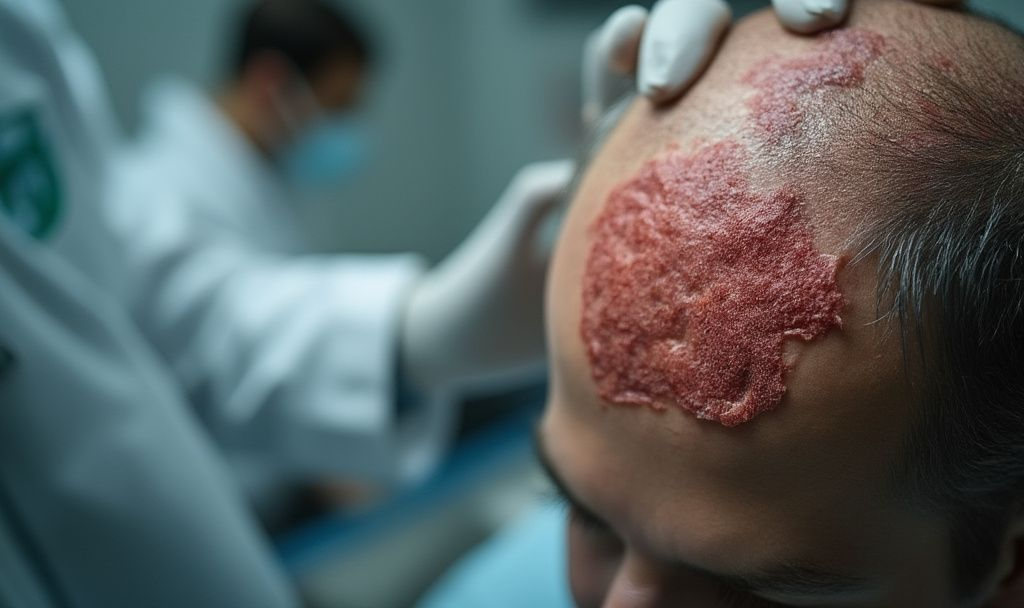Curious about scalp psoriasis and its appearance? This condition often forms thick, scaly patches under the hair, sparking concern due to its visual impact. Viewing images can help differentiate it from other scalp issues, offering clarity as you pursue an accurate diagnosis and effective treatment.

Understanding Scalp Psoriasis
Scalp psoriasis is a common skin condition that affects many individuals, yet it often goes unnoticed due to its location beneath the hair. This chronic autoimmune disorder results in thick, scaly patches on the scalp, occasionally extending to the hairline or nape. Its appearance can be alarming, leading individuals to seek visual confirmation. If you’re curious or concerned about scalp psoriasis, understanding its visual aspects might help distinguish it from other conditions.
Those searching for images of scalp psoriasis do so to compare symptoms such as flaking, redness, and itchiness with medical references to self-assess their condition. The goal for many is to gain reassurance or support in conversations with healthcare professionals. Recognizing the differences between scalp psoriasis and similar issues, like dandruff or seborrheic dermatitis, is essential for accurate identification. For a comprehensive gallery of images, platforms like DermNet offer validated resources for visual reference.
The Importance of Accurate Identification
Accurately identifying scalp psoriasis can significantly affect treatment and management. Because its symptoms often resemble other common scalp issues, many people might misinterpret them, leading to ineffective over-the-counter remedies or unnecessary concern. Seeking visual aids is a logical first step for anyone suspecting they might have this condition. Medical image galleries, like those on eMedicineHealth, provide credible examples.
It’s essential to remember that while pictures can guide, they do not replace professional medical diagnosis. If symptoms persist or cause significant discomfort, consulting a dermatologist is crucial. Beyond identifying symptoms, trained professionals can tailor treatments to individual needs, offering relief from persistent itchiness or unsightly patches. For a layperson, tools such as symptom checkers on sites like Healthline may provide a general understanding, enhancing confidence before a medical appointment.
Impact on Daily Life
Living with scalp psoriasis can affect daily life and self-esteem. The visible symptoms, like flaky skin, often lead to misconceptions about hygiene, resulting in embarrassment or social discomfort. This visibility impacts mental health, leading some to withdraw from social situations. Moreover, the fear of hair loss or public scrutiny can exacerbate anxiety, negatively affecting one’s quality of life.
Breaking the stigma around scalp psoriasis is crucial for improving the lives of those affected. Increasing awareness through social discussions and media representation helps demystify the condition. Programs and support groups, such as those offered by the National Psoriasis Foundation, provide a community for shared experiences, reducing the emotional burden. During periods like National Psoriasis Awareness Month, these efforts intensify, promoting acceptance and compassion.
Resources and Tools for Support
Numerous tools and resources are available for individuals seeking information or support regarding scalp psoriasis. Websites like WebMD offer slideshows and symptom checkers that enhance understanding of the condition’s presentation. For those who prefer digital health services, dermatology telehealth solutions allow for photo uploads and virtual consultations, delivering professional opinions conveniently.
It’s equally important to consider policy aspects. Ethical considerations emphasize that images depicting scalp psoriasis should include disclaimers, ensuring viewers understand these images cannot substitute professional evaluations. These resources amplify diverse representation in medical imagery, fostering inclusivity and sensitivity across different skin tones. As telemedicine gains prominence, using secure, reliable platforms ensures patient privacy and comfort.
Frequently Asked Questions (FAQs)
What are the common symptoms of scalp psoriasis?
Common symptoms of scalp psoriasis include thick, scaly patches on the scalp, flaking, redness, and persistent itchiness that may extend to the hairline or nape.
How can I tell the difference between scalp psoriasis and dandruff?
While both conditions involve flaking, scalp psoriasis often includes thicker scales and more redness, whereas dandruff typically presents as smaller, greasy flakes.
Why is it important to accurately identify scalp psoriasis?
Accurate identification is crucial because it ensures appropriate treatment and prevents the use of ineffective over-the-counter remedies that might not address psoriasis.
How does scalp psoriasis impact daily life?
Scalp psoriasis can affect self-esteem and mental health due to visible symptoms like flaking and redness, leading to social discomfort and misconceptions about personal hygiene.
What resources are available for support with scalp psoriasis?
Resources include websites like WebMD, telehealth consultations for professional opinions, and support groups provided by organizations like the National Psoriasis Foundation.
